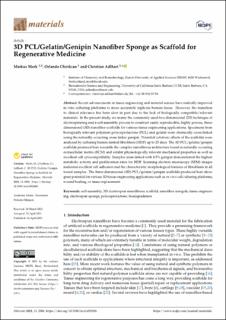Bitte benutzen Sie diese Kennung, um auf die Ressource zu verweisen:
https://doi.org/10.21256/zhaw-22298| Publikationstyp: | Beitrag in wissenschaftlicher Zeitschrift |
| Art der Begutachtung: | Open peer review |
| Titel: | 3D PCL/gelatin/genipin nanofiber sponge as scaffold for regenerative medicine |
| Autor/-in: | Merk, Markus Chirikian, Orlando Adlhart, Christian |
| et. al: | No |
| DOI: | 10.3390/ma14082006 10.21256/zhaw-22298 |
| Erschienen in: | Materials |
| Band(Heft): | 14 |
| Heft: | 8 |
| Seite(n): | 2006 |
| Erscheinungsdatum: | 2021 |
| Verlag / Hrsg. Institution: | MDPI |
| ISSN: | 1996-1944 |
| Sprache: | Englisch |
| Schlagwörter: | Self-assembly; 3D electrospun nanofibrous scaffold; Nanofiber aerogels; Tissue engineering; Electrospun sponge; Polycaprolactone; Biodegradation |
| Fachgebiet (DDC): | 610.28: Biomedizin, Biomedizinische Technik |
| Zusammenfassung: | Recent advancements in tissue engineering and material science have radically improved in vitro culturing platforms to more accurately replicate human tissue. However, the transition to clinical relevance has been slow in part due to the lack of biologically compatible/relevant materials. In the present study, we marry the commonly used two-dimensional (2D) technique of electrospinning and a self-assembly process to construct easily reproducible, highly porous, three-dimensional (3D) nanofiber scaffolds for various tissue engineering applications. Specimens from biologically relevant polymers polycaprolactone (PCL) and gelatin were chemically cross-linked using the naturally occurring cross-linker genipin. Potential cytotoxic effects of the scaffolds were analyzed by culturing human dermal fibroblasts (HDF) up to 23 days. The 3D PCL/gelatin/genipin scaffolds produced here resemble the complex nanofibrous architecture found in naturally occurring extracellular matrix (ECM) and exhibit physiologically relevant mechanical properties as well as excellent cell cytocompatibility. Samples cross-linked with 0.5% genipin demonstrated the highest metabolic activity and proliferation rates for HDF. Scanning electron microscopy (SEM) images indicated excellent cell adhesion and the characteristic morphological features of fibroblasts in all tested samples. The three-dimensional (3D) PCL/gelatin/genipin scaffolds produced here show great potential for various 3D tissue-engineering applications such as ex vivo cell culturing platforms, wound healing, or tissue replacement. |
| Weitere Angaben: | Special Issue "Organic Nanofibers : Fabrication, Properties and Applications" |
| URI: | https://digitalcollection.zhaw.ch/handle/11475/22298 |
| Volltext Version: | Publizierte Version |
| Lizenz (gemäss Verlagsvertrag): | CC BY 4.0: Namensnennung 4.0 International |
| Departement: | Life Sciences und Facility Management |
| Organisationseinheit: | Institut für Chemie und Biotechnologie (ICBT) |
| Enthalten in den Sammlungen: | Publikationen Life Sciences und Facility Management |
Dateien zu dieser Ressource:
| Datei | Beschreibung | Größe | Format | |
|---|---|---|---|---|
| 2021_Merk-etal_3D-PCL-Gelatin-Genipin-nanofiber-sponge.pdf | 2.75 MB | Adobe PDF |  Öffnen/Anzeigen |
Zur Langanzeige
Merk, M., Chirikian, O., & Adlhart, C. (2021). 3D PCL/gelatin/genipin nanofiber sponge as scaffold for regenerative medicine. Materials, 14(8), 2006. https://doi.org/10.3390/ma14082006
Merk, M., Chirikian, O. and Adlhart, C. (2021) ‘3D PCL/gelatin/genipin nanofiber sponge as scaffold for regenerative medicine’, Materials, 14(8), p. 2006. Available at: https://doi.org/10.3390/ma14082006.
M. Merk, O. Chirikian, and C. Adlhart, “3D PCL/gelatin/genipin nanofiber sponge as scaffold for regenerative medicine,” Materials, vol. 14, no. 8, p. 2006, 2021, doi: 10.3390/ma14082006.
MERK, Markus, Orlando CHIRIKIAN und Christian ADLHART, 2021. 3D PCL/gelatin/genipin nanofiber sponge as scaffold for regenerative medicine. Materials. 2021. Bd. 14, Nr. 8, S. 2006. DOI 10.3390/ma14082006
Merk, Markus, Orlando Chirikian, and Christian Adlhart. 2021. “3D PCL/Gelatin/Genipin Nanofiber Sponge as Scaffold for Regenerative Medicine.” Materials 14 (8): 2006. https://doi.org/10.3390/ma14082006.
Merk, Markus, et al. “3D PCL/Gelatin/Genipin Nanofiber Sponge as Scaffold for Regenerative Medicine.” Materials, vol. 14, no. 8, 2021, p. 2006, https://doi.org/10.3390/ma14082006.
Alle Ressourcen in diesem Repository sind urheberrechtlich geschützt, soweit nicht anderweitig angezeigt.